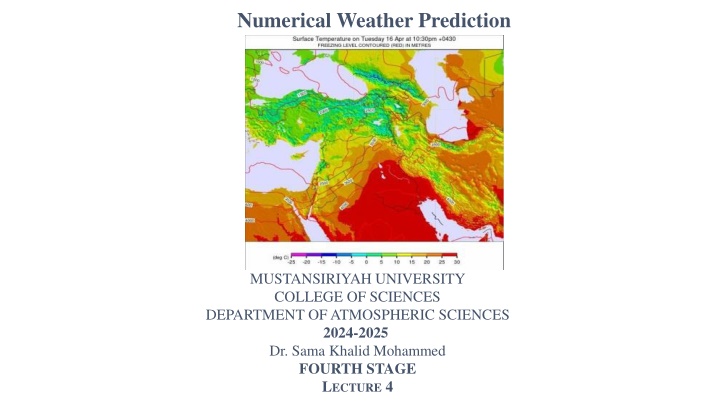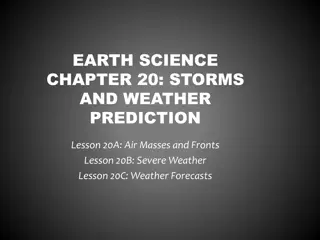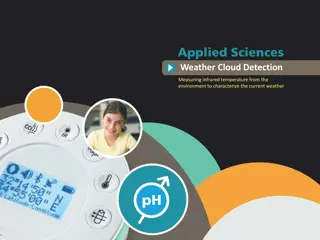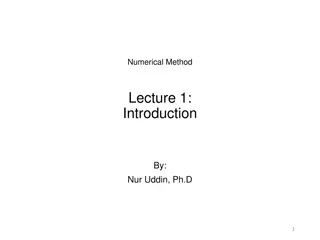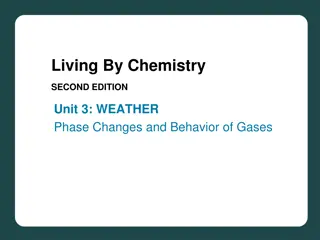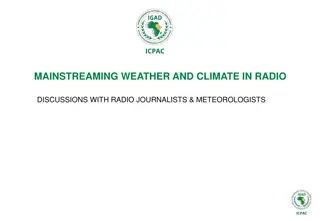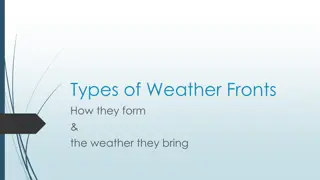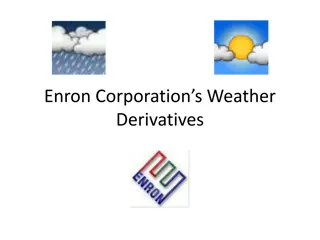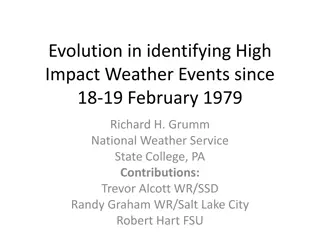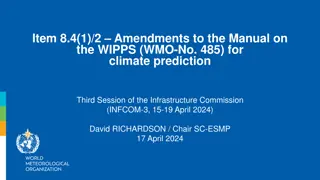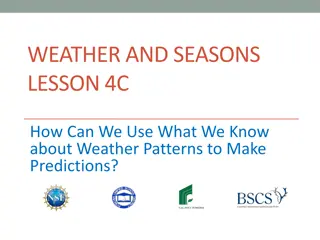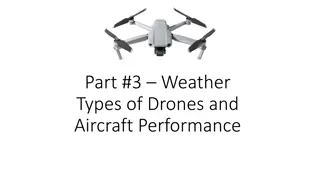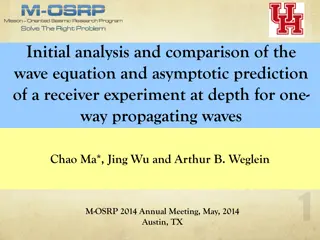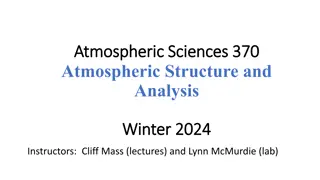Numerical Weather Prediction
"The Department of Atmospheric Sciences at Mustansiriya University College of Sciences offers a comprehensive course on Numerical Weather Prediction taught by Dr. Sama Khalid Mohammed. Dive into the fundamentals of weather modeling, forecasting techniques, and advanced meteorological concepts in this fourth-stage lecture. Explore the exciting world of atmospheric sciences through hands-on learning and real-world applications."
Download Presentation

Please find below an Image/Link to download the presentation.
The content on the website is provided AS IS for your information and personal use only. It may not be sold, licensed, or shared on other websites without obtaining consent from the author.If you encounter any issues during the download, it is possible that the publisher has removed the file from their server.
You are allowed to download the files provided on this website for personal or commercial use, subject to the condition that they are used lawfully. All files are the property of their respective owners.
The content on the website is provided AS IS for your information and personal use only. It may not be sold, licensed, or shared on other websites without obtaining consent from the author.
E N D
Presentation Transcript
Numerical Weather Prediction MUSTANSIRIYAH UNIVERSITY COLLEGE OF SCIENCES DEPARTMENT OF ATMOSPHERIC SCIENCES 2024-2025 Dr. Sama Khalid Mohammed FOURTH STAGE LECTURE 4
Back to the primitive equations and initialization Summery Primitive equations: Equations modeling atmospheric evolution, sensitive to gravity waves and requiring frequent calculations. Initialization problem: Ensuring wind and pressure fields are balanced at the start to prevent unrealistic oscillations. Nonlinear normal mode initialization: A technique developed in the 1970s to solve the initialization problem, making primitive equations more effective in weather prediction.
Back to the primitive equations and initialization As computers became faster, meteorologists could return to using the primitive equations the full set of fluid dynamics equations used in weather modeling. These equations were first used by Richardson and include rapidly propagating inertia- gravity waves as solutions. However, to keep the model stable under the CFL condition (which ensures numerical stability), these models require much smaller time steps about six times smaller than those needed with filtered equations. This increases the total number of steps (Nt) the model has to compute. Primitive equations: Represent the full atmospheric system in hydrostatic equilibrium, including fast-moving inertia-gravity waves. Early work: Research on these equations was carried out by Eliassen (1956), with successful tests in the U.S. by Smagorinsky (1958) and in Germany by Hinkelmann (1959).
Back to the primitive equations and initialization Operational models: The first operational primitive equation model was introduced in 1966 by Shuman and Hovermale, covering the northern hemisphere with a 381 km grid and six vertical levels. This set the stage for more widespread use of such models. The Initialization Problem Although primitive equation models are relatively easy to implement, they have a key challenge: the initialization problem. The pressure and wind fields must be in balance at the start of the simulation; otherwise, they will generate unrealistic oscillations caused by large-amplitude gravity waves. This problem of imbalance is what led to Richardson s unrealistic result in his early numerical weather prediction attempt.
Back to the primitive equations and initialization Static initialization methods whereby the wind field is deduced pressure field using a linear or nonlinear equation proved comparatively ineffective; moreover, wind observations were not really used then for defining the initial state. It was in the late 1970s that an elegant solution to the problem of initialization of global fields was found, independently by Baer and Tribbia (1977) and by Machenhauer (1977). The idea was to decompose the initial state of the atmosphere into normal modes (that is, into solutions of a linearized version of the model) and then to correct the inertia-gravity modes in the initial state so as to make them stationary when the model evolved . This technique of nonlinear normal mode initialization meant primitive equation models could be used effectively to take full advantage of initial pressure and wind data. from the
Global processing and the spectral method Summery: As weather models evolved from regional to global scales, they faced challenges related to grid size and instability near the poles. Spectral models, which represent atmospheric fields using mathematical expansions (spherical harmonics), became more efficient with the development of the fast Fourier transform. This allowed the spectral method to replace grid point models in most global weather models by the 1980s.
Global processing and the spectral method Prediction over longer time ranges requires larger working areas: When making weather predictions for longer periods, the area being studied must be expanded. This is because disturbances in the atmosphere (like storms or wind changes) move over large distances. To account for these, you need to increase the number of points (Nv) in the model grid. The larger the area, the more points you need to model the system accurately. Evolution of weather models from limited areas to global models: Initially, weather models were focused on small geographic areas, then expanded to cover hemispheres (either the northern or southern hemisphere). Eventually, models became global, meaning they covered the entire Earth. This shift allowed meteorologists to handle interactions between the two hemispheres, which is important for accurate predictions.
Global processing and the spectral method Challenges with modeling on a spherical Earth: When moving to global models, a grid had to be created on the surface of a sphere (since Earth is round). However, grid points are more densely packed near the poles, causing instability in the model. This issue had to be addressed to maintain the model's stability. Introduction of spectral models: Alongside traditional grid point models that use the finite difference method (where you calculate values at specific points on the grid), another approach called spectral models was developed. In these models, fields (like wind, temperature, etc.) are represented using spherical harmonics (a kind of mathematical series that fits the surface of a sphere). Spectral models provide a more accurate way of evaluating wave speeds (which is important for predicting how weather patterns evolve) than the finite difference method.
Global processing and the spectral method Improvement with the fast Fourier transform: Initially, spectral models were used only in simple cases with limited data because they required a lot of computation to calculate the expansion coefficients for the nonlinear terms in the equations. This changed with the development of the fast Fourier transform (FFT), an efficient algorithm introduced by Cooley and Tukey in 1965, where nonlinear terms could be calculated more efficiently on an intermediate grid. This breakthrough (as demonstrated by Orszag and Eliassen in 1970) made spectral models much more competitive. A hemispheric 500-hPa height field If the height data are tabulated at 40 N latitude every 10 degrees of longitude (represented at each yellow dot on the chart), there are 36 points around the globe. It takes a minimum of five to seven points to reasonably represent a wave and, in this case, five or six waves can be defined with the data. The locations of the wave troughs are shown in the top part as solid red lines. the shorter waves represent the synoptic-scale features, while the longer waves represent planetary features.
Global processing and the spectral method Spectral method dominance in global models: Due to these advancements, by the 1980s, the spectral method became the dominant approach for global weather models. It outperformed traditional grid point models because of its efficiency and accuracy, particularly in handling wave speeds and large-scale atmospheric dynamics.
Limited area models Summary: Limited Area Models (LAMs) are designed to make detailed short-range weather forecasts for small areas using fine grids to capture local weather patterns. These models rely on boundary conditions from larger-scale models and use special techniques (like dissipation terms) to avoid disturbances. Spectral methods and normal mode nonlinear initialization techniques, originally used in global models, were adapted to improve the performance of limited area models. Digital filtering was later introduced to handle fast atmospheric waves, further refining the initialization process for accurate predictions.
Limited area models Expanding the area for longer forecasts: To extend weather forecasts to longer periods, it was necessary to expand the geographical area being studied. This allows the model to consider large-scale atmospheric processes that influence long-term weather changes. Short-range forecasting (1 2 days): For short-term weather forecasts (1 to 2 days), working within a restricted area can still be effective. However, a fine grid (with smaller mesh size) is needed to capture small-scale weather patterns (like local winds and temperature changes), especially those influenced by the terrain (such as mountains).Limited Area Models (LAMs) were developed for this purpose. These models focus on small regions and short periods of time, providing detailed predictions.
Limited area models Boundary conditions: In LAMs, the values at the edges of the modeled area (the boundary) need to be set for each time step to ensure the model runs correctly. These values are often taken from larger-scale models that cover a broader area and then interpolated to fit the smaller model. However, when these boundary values are applied, they can introduce unwanted disturbances (or perturbations) into the smaller model. To prevent these disturbances from affecting the forecast, a dissipation term is introduced to dampen the effects of these disturbances as they move toward the interior of the model. Nested models: This leads to the development of nested models, where smaller models (LAMs) are "nested" within larger models. This method forms the basis of many operational prediction systems used by meteorological services to improve short-range forecasts.
Limited area models Applying spectral methods to limited area models: Spectral methods (which use mathematical functions to represent the atmosphere s behavior) were very effective in global models. There was interest in applying these methods to limited area models as well. One approach by Machenhauer and Haugen (1987) extended the model fields beyond the limited area, making them doubly periodic (meaning they repeat at the boundaries). This allowed the spectral method to be applied in smaller areas using trigonometric functions. Nonlinear initialization in limited area models: In global models, a technique called nonlinear normal mode initialization was used to stabilize the model by adjusting fast-moving atmospheric waves (such as inertia-gravity waves) to make them stationary. This technique was successfully applied to limited area models as well. Later, Lynch and Huang (1992) proposed a method called digital filtering, which removed the high-frequency components related to inertia-gravity waves, providing a better solution for initializing limited area models and improving their accuracy.
